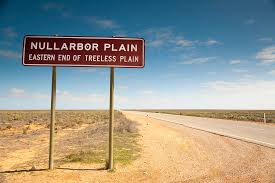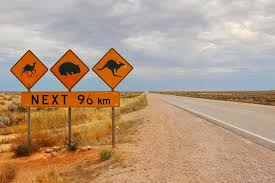This week we are looking at the area of Australia called The Nullarbor Plain, which means "no trees" in Latin, is a vast, arid region in southern Australia with a rich history, both for Indigenous Australians and Europeans.
Historically, it was seasonally occupied by the Mirning and Yinyila Indigenous peoples, who knew it as Oondiri, meaning "waterless".
Europeans first charted the coast in the 17th century, but the interior remained largely unexplored until Edward Eyre’s epic crossing in 1841. The Nullarbor has since been a site of pastoralism, railway construction, and even nuclear testing, shaping its modern landscape and infrastructure. They have a deep and continuing connection to the Nullarbor.
The name "Nullarbor" was coined by surveyor Edmund Delissern
in1865. Pastoralists established
stations along the telegraph and railway lines, and small settlements developed
around these.
The Nullarbor was used for nuclear
testing in the 1950s, leading to the displacement of Indigenous populations.
The Trans-Australian Railway completed
in 1917, facilitated travel and trade across the Nullarbor.
The Eyre Highway. A road across the
Nullarbor, was completed in 1976, connecting South Australia and Western
Australia. The highway is a 1,664-kilometre, it is signed as National Highways
1 and A1, it forms part of Highway 1 and the Australian National Highway
network linking Perth and Adelaide.
Driving directly across the Nullarbor Plain (from Norseman to Ceduna) takes approximately 12.5 hours of non-stop driving. However, most travellers allocate 2-3 days for the journey to allow for stops at attractions, wildlife viewing, and enjoying the scenery.
When driving across the Nullarbor people need to beware of trucks as there are triple-decker road trains which have brutal slipstreams, so slow down or pull over to let them pass. Also at night the road. turns into a marsupial rave party at night, from camels, kangaroos, dingoes and occasionally wombats. With no phone service, no other travellers, and emergency services hours away, getting into an accident could leave you stranded without help.
When camping Nullarbor, keep an eye out for scorpions,
bird-eating spiders, eastern brown snakes, and death adders. Avoid setting up
camp near bodies of water, high vegetation, rocks, fallen logs, or under trees.
Also, remind curious kiddos that sticking hands in holes in the ground, under
rocks, logs, or trees could disturb a creepy crawly!
If you run into trouble, do not leave your vehicle to search for
help. Drones, planes, foot searches, and car trackers will see a vehicle and
find you.
The area is known for its vast cave systems, some of which
contain fossils and provide insights into the region's past climate.
The Nullarbor continues to be a place of both natural beauty and
human activity, with tourism and transport playing a significant role.








Good to read Jo-Anne. Have been across it three times and enjoyed every minute of it.
ReplyDeleteThanks Margaret my parents crossed it a couple of times
DeleteSounds like a scary place to be!
ReplyDeleteNot somewhere you want to break down
DeleteUmm yeah, I don't think that would be on my list of places to visit, except I do love seeing the wildlife.
ReplyDeleteIt's an area you need a reliable car as not a place to break down
DeleteI would NOT enjoy visiting that at all, Jo-Anne. It's too bleak and dangerous in my view. Thanks for sharing!
ReplyDeleteI get that
DeleteThat sounds more like "wild death" than wild life...
ReplyDeleteCan be dangerous
DeleteOMG, I'd love to see the wildlife but I'm not sure about this adventure.
ReplyDeleteNot a place to do silly things or wonder off on foot
Delete